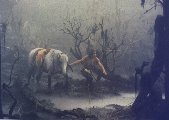 The look and feel of the "Swamps of Sadness" can be credited to the
effort of Wolfgang Zehetbauer, who was responsible for the creation
of the 3000 square meters of muddy wasteland. The final result matched,
and probably even exceeded, the literary conception of
book. Enormous quantities of mud, plants and water had to be used
to form the depressing landscape which stood in hall 4/5 of the
Bavaria Studio's for several weeks.
The look and feel of the "Swamps of Sadness" can be credited to the
effort of Wolfgang Zehetbauer, who was responsible for the creation
of the 3000 square meters of muddy wasteland. The final result matched,
and probably even exceeded, the literary conception of
book. Enormous quantities of mud, plants and water had to be used
to form the depressing landscape which stood in hall 4/5 of the
Bavaria Studio's for several weeks.
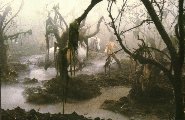 Creating the swamp was not an easy task. As many of the ingredients that made
up the landscape were not to be mixed, many small raster-like basins
had to be created with depths of approximately 30 cm. Plants and peat
were used to camouflage the transitions between the numerous basins and
one of the larger ones was especially made to be lowered for the scene
in which Artax had to sink to his death. To make the scenes not just
realistic, but also more depressing, no colours but only grey tones
had to be used, and some of the trees were even squirted black. The dark
depresing mood was also enhanced with fog and smoke simulated
with dry ice and blown out unto the set through hoses. In many scenes
the smoke actually replaced the background. Large quantities of frying
oil were used and Mr.Eysenn tells in his book how everything smelled
like the kitchen of a fastfood restaurant. Thereupon, one the smokemakers
named Sam added some Indian Perfume to counteract the foul smell.
Creating the swamp was not an easy task. As many of the ingredients that made
up the landscape were not to be mixed, many small raster-like basins
had to be created with depths of approximately 30 cm. Plants and peat
were used to camouflage the transitions between the numerous basins and
one of the larger ones was especially made to be lowered for the scene
in which Artax had to sink to his death. To make the scenes not just
realistic, but also more depressing, no colours but only grey tones
had to be used, and some of the trees were even squirted black. The dark
depresing mood was also enhanced with fog and smoke simulated
with dry ice and blown out unto the set through hoses. In many scenes
the smoke actually replaced the background. Large quantities of frying
oil were used and Mr.Eysenn tells in his book how everything smelled
like the kitchen of a fastfood restaurant. Thereupon, one the smokemakers
named Sam added some Indian Perfume to counteract the foul smell.
The illusion of endlessness was created with simple tricks of perception.
While normal (approximately 5 m high) trees were placed on the foreground,
the trees became smaller and smaller to the back of the set (up to 30 cm).
In addition, the set was sloped upwards with an approximate 1,30 meter hight
diference between the fore- and background, thus creating the illusion of
the horizon. Naturally, the optical deception only worked while the actors
moved in the front area of the set. Otherwise the discrepancy of size
would become noticeable immediately. Furthermore, the camera had to remain
under the height of the apparent horizon at all times.

One of the largest problems facing the crew during the production
on the set, were the hot temperatures and the dirt. When the swamp
scenes were shot at the beginning of June 1983, Germany was plagued by
the worst heat-wave in 25 years. Furthermore, with the nature of the
set and everything, it could not be avoided that everything and everyone
got wet and dirty from the mud. One of cameraman actually fell into the
swamp one time but miraculously managed to keep his camera from breaking.
 Over a period of three weeks, three seperate scenes were shot
at the Swamp-set. These were the scenes with Artax and him
sinking away to his death, the scenes with the ancient Morla
(including crashing out of the tree and the sliding from
her back into a pool of mud), and the scenes of the Gmork in
hot pursuit of Atreyu.
Over a period of three weeks, three seperate scenes were shot
at the Swamp-set. These were the scenes with Artax and him
sinking away to his death, the scenes with the ancient Morla
(including crashing out of the tree and the sliding from
her back into a pool of mud), and the scenes of the Gmork in
hot pursuit of Atreyu.
 Of these three scenes, the scene of Artax's death is the most
moving and dramatic one of the whole movie. The parts of the scene
where Atreyu leads Atrex through the Swamp were relatively easy
to shoot, but problems arose in the part where Artex is
overwhelmed by hopelesness and slowly sinks into the mud to a certain
death while Atreyu calls out to his friend not to give up and to keep
on fighting.
Of these three scenes, the scene of Artax's death is the most
moving and dramatic one of the whole movie. The parts of the scene
where Atreyu leads Atrex through the Swamp were relatively easy
to shoot, but problems arose in the part where Artex is
overwhelmed by hopelesness and slowly sinks into the mud to a certain
death while Atreyu calls out to his friend not to give up and to keep
on fighting.
Bordering on cruelty to animals, the horse portraying Artax was chained to
a lifting platform which could slowly be lowered into the
swamp. To ensure that the horse would not be mentally damaged, he was
carefully trained for weeks by horse coach Tony Smart.
In addition, a deep ditch was dug between the accommodation halls and filled
with water through which the horse was led again and again.
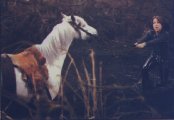 The training was nevertheless insufficient, as R. Eyssen tells in his book,
for the horse did not let the sadness of the swamp get to him and he did not
go down without a fight. With an energetic jerk of the heading, the
horse caused Noah to splash into the swamp and hurt his leg to the edge of the lifting platform.
As dirty as he was, Noah was immediately driven to the hospital. The physician
on duty must really have been surprised to treat a mudd-covered Indian boy
carried by a man in a white paper suit and hearing a tale about lifting
platforms, swamps and horses. Fortunately Noah was back on the set after
a mere two days.
The training was nevertheless insufficient, as R. Eyssen tells in his book,
for the horse did not let the sadness of the swamp get to him and he did not
go down without a fight. With an energetic jerk of the heading, the
horse caused Noah to splash into the swamp and hurt his leg to the edge of the lifting platform.
As dirty as he was, Noah was immediately driven to the hospital. The physician
on duty must really have been surprised to treat a mudd-covered Indian boy
carried by a man in a white paper suit and hearing a tale about lifting
platforms, swamps and horses. Fortunately Noah was back on the set after
a mere two days.
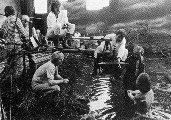
Less dramatic was the scene where Atreyu glides down the slopes of Shell-Mountain
as it turns out to be the shell of the ancient turtle named Morla. This small scene
alone took a whole day to shoot. As the slide was deemed an unnecessary risk for
the leading actor, stuntman Bobby Porter, one of the very few people in the world
able to realisticaly double for a child of Noah's age, was flown in from the States.
The camera was positioned in such a way that instead of a full-blown Morla, only a
very small part of her shell was seen, namely the top with the breaking tree,
and the part where Atreyu slides down. Thus no model of Morla was needed. The
slide was made of a normal water-chute with the appropriate decoration ofcoarse,
had a hight of ten meters and ended in a two meter freefall into a pool of mud.
 Timing was critical to this scene, for the mud, which had to be laboriously carried
up to the top by hand, had to be released at just the right moment, when Atreyu
would in the track and the camera was moving at just the right angle. The mud was
poured out over the canvas, from which one or two ripped ofcoarse. Another problem
was the slimyness of the mud. To thick, and it didn't allow sliding. And to top
it allof, all the attempts needed to get the scene just right, made the decorations go
bad and dissolve. The fact that at that day of all days, the insurance agents
decided to make a visit to the set, didn't make things any easier either.
Timing was critical to this scene, for the mud, which had to be laboriously carried
up to the top by hand, had to be released at just the right moment, when Atreyu
would in the track and the camera was moving at just the right angle. The mud was
poured out over the canvas, from which one or two ripped ofcoarse. Another problem
was the slimyness of the mud. To thick, and it didn't allow sliding. And to top
it allof, all the attempts needed to get the scene just right, made the decorations go
bad and dissolve. The fact that at that day of all days, the insurance agents
decided to make a visit to the set, didn't make things any easier either.
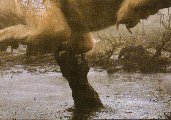 To save production time and costs, the pursuit scenes of the Gmork were predominantly
shot at night under the direction by H.Nikel while Noah's scenes were done during the
day. The effects of the persuit as seen from the Gmork's point of view, was achieved
by the use of a so-called Steadycam. By use of springs, absorbers and counterweights,
the camera was attached to the cameraman in such a way, that it always remained
counterbalanced, no matter how the cameraman moved. All he had to then was to walk
the path of the Gmork.
To save production time and costs, the pursuit scenes of the Gmork were predominantly
shot at night under the direction by H.Nikel while Noah's scenes were done during the
day. The effects of the persuit as seen from the Gmork's point of view, was achieved
by the use of a so-called Steadycam. By use of springs, absorbers and counterweights,
the camera was attached to the cameraman in such a way, that it always remained
counterbalanced, no matter how the cameraman moved. All he had to then was to walk
the path of the Gmork.
Within this scene, a dog with a wolf skin was intended to play the part of
the Gmork, but this would have looked to obvious. Instead, two paws were made
and fastened to the hands of a co-worker, who was then carried through the swamp
on a stretcher.
Stephan wrote: The guide at the Bavaria Film
Studios declared at their tour that the mud came from
excavator works at the river Isar (through Munich). The mud was
put to trucks and tipped down at the set. They didn't thought
about that the mud is full of insect larvas in this season.
The larvas comfort so much in the warm spot lights of the set
that they slip after a few days. The swarms of insects were so
big that a fim shooting was impossible. The vermin exterminator
needed two days to clean the set insect free.
Thanks, Stephan.
Julia wrote: Because the mud couldn't prepared
insect free they took artifical mud. That wasted more shooting
days and money. And, the real white horse didn't want into the
mud anymore, neither in real mud nor in the artifical one. That's
why they used another brown horse which had to be colored white
(from the interesting Bavaria Film Tour ;-)
Danke, Julia.
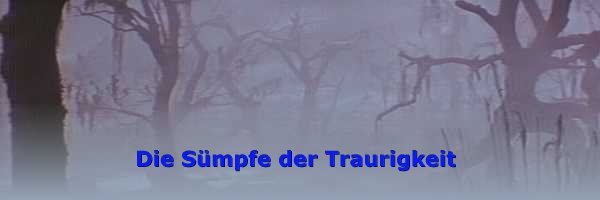

 The look and feel of the "Swamps of Sadness" can be credited to the
effort of Wolfgang Zehetbauer, who was responsible for the creation
of the 3000 square meters of muddy wasteland. The final result matched,
and probably even exceeded, the literary conception of
book. Enormous quantities of mud, plants and water had to be used
to form the depressing landscape which stood in hall 4/5 of the
Bavaria Studio's for several weeks.
The look and feel of the "Swamps of Sadness" can be credited to the
effort of Wolfgang Zehetbauer, who was responsible for the creation
of the 3000 square meters of muddy wasteland. The final result matched,
and probably even exceeded, the literary conception of
book. Enormous quantities of mud, plants and water had to be used
to form the depressing landscape which stood in hall 4/5 of the
Bavaria Studio's for several weeks.
 Creating the swamp was not an easy task. As many of the ingredients that made
up the landscape were not to be mixed, many small raster-like basins
had to be created with depths of approximately 30 cm. Plants and peat
were used to camouflage the transitions between the numerous basins and
one of the larger ones was especially made to be lowered for the scene
in which Artax had to sink to his death. To make the scenes not just
realistic, but also more depressing, no colours but only grey tones
had to be used, and some of the trees were even squirted black. The dark
depresing mood was also enhanced with fog and smoke simulated
with dry ice and blown out unto the set through hoses. In many scenes
the smoke actually replaced the background. Large quantities of frying
oil were used and Mr.Eysenn tells in his book how everything smelled
like the kitchen of a fastfood restaurant. Thereupon, one the smokemakers
named Sam added some Indian Perfume to counteract the foul smell.
Creating the swamp was not an easy task. As many of the ingredients that made
up the landscape were not to be mixed, many small raster-like basins
had to be created with depths of approximately 30 cm. Plants and peat
were used to camouflage the transitions between the numerous basins and
one of the larger ones was especially made to be lowered for the scene
in which Artax had to sink to his death. To make the scenes not just
realistic, but also more depressing, no colours but only grey tones
had to be used, and some of the trees were even squirted black. The dark
depresing mood was also enhanced with fog and smoke simulated
with dry ice and blown out unto the set through hoses. In many scenes
the smoke actually replaced the background. Large quantities of frying
oil were used and Mr.Eysenn tells in his book how everything smelled
like the kitchen of a fastfood restaurant. Thereupon, one the smokemakers
named Sam added some Indian Perfume to counteract the foul smell.

 Over a period of three weeks, three seperate scenes were shot
at the Swamp-set. These were the scenes with Artax and him
sinking away to his death, the scenes with the ancient Morla
(including crashing out of the tree and the sliding from
her back into a pool of mud), and the scenes of the Gmork in
hot pursuit of Atreyu.
Over a period of three weeks, three seperate scenes were shot
at the Swamp-set. These were the scenes with Artax and him
sinking away to his death, the scenes with the ancient Morla
(including crashing out of the tree and the sliding from
her back into a pool of mud), and the scenes of the Gmork in
hot pursuit of Atreyu.
 Of these three scenes, the scene of Artax's death is the most
moving and dramatic one of the whole movie. The parts of the scene
where Atreyu leads Atrex through the Swamp were relatively easy
to shoot, but problems arose in the part where Artex is
overwhelmed by hopelesness and slowly sinks into the mud to a certain
death while Atreyu calls out to his friend not to give up and to keep
on fighting.
Of these three scenes, the scene of Artax's death is the most
moving and dramatic one of the whole movie. The parts of the scene
where Atreyu leads Atrex through the Swamp were relatively easy
to shoot, but problems arose in the part where Artex is
overwhelmed by hopelesness and slowly sinks into the mud to a certain
death while Atreyu calls out to his friend not to give up and to keep
on fighting.
 The training was nevertheless insufficient, as R. Eyssen tells in his book,
for the horse did not let the sadness of the swamp get to him and he did not
go down without a fight. With an energetic jerk of the heading, the
horse caused Noah to splash into the swamp and hurt his leg to the edge of the lifting platform.
As dirty as he was, Noah was immediately driven to the hospital. The physician
on duty must really have been surprised to treat a mudd-covered Indian boy
carried by a man in a white paper suit and hearing a tale about lifting
platforms, swamps and horses. Fortunately Noah was back on the set after
a mere two days.
The training was nevertheless insufficient, as R. Eyssen tells in his book,
for the horse did not let the sadness of the swamp get to him and he did not
go down without a fight. With an energetic jerk of the heading, the
horse caused Noah to splash into the swamp and hurt his leg to the edge of the lifting platform.
As dirty as he was, Noah was immediately driven to the hospital. The physician
on duty must really have been surprised to treat a mudd-covered Indian boy
carried by a man in a white paper suit and hearing a tale about lifting
platforms, swamps and horses. Fortunately Noah was back on the set after
a mere two days.

 Timing was critical to this scene, for the mud, which had to be laboriously carried
up to the top by hand, had to be released at just the right moment, when Atreyu
would in the track and the camera was moving at just the right angle. The mud was
poured out over the canvas, from which one or two ripped ofcoarse. Another problem
was the slimyness of the mud. To thick, and it didn't allow sliding. And to top
it allof, all the attempts needed to get the scene just right, made the decorations go
bad and dissolve. The fact that at that day of all days, the insurance agents
decided to make a visit to the set, didn't make things any easier either.
Timing was critical to this scene, for the mud, which had to be laboriously carried
up to the top by hand, had to be released at just the right moment, when Atreyu
would in the track and the camera was moving at just the right angle. The mud was
poured out over the canvas, from which one or two ripped ofcoarse. Another problem
was the slimyness of the mud. To thick, and it didn't allow sliding. And to top
it allof, all the attempts needed to get the scene just right, made the decorations go
bad and dissolve. The fact that at that day of all days, the insurance agents
decided to make a visit to the set, didn't make things any easier either.
 To save production time and costs, the pursuit scenes of the Gmork were predominantly
shot at night under the direction by H.Nikel while Noah's scenes were done during the
day. The effects of the persuit as seen from the Gmork's point of view, was achieved
by the use of a so-called Steadycam. By use of springs, absorbers and counterweights,
the camera was attached to the cameraman in such a way, that it always remained
counterbalanced, no matter how the cameraman moved. All he had to then was to walk
the path of the Gmork.
To save production time and costs, the pursuit scenes of the Gmork were predominantly
shot at night under the direction by H.Nikel while Noah's scenes were done during the
day. The effects of the persuit as seen from the Gmork's point of view, was achieved
by the use of a so-called Steadycam. By use of springs, absorbers and counterweights,
the camera was attached to the cameraman in such a way, that it always remained
counterbalanced, no matter how the cameraman moved. All he had to then was to walk
the path of the Gmork.